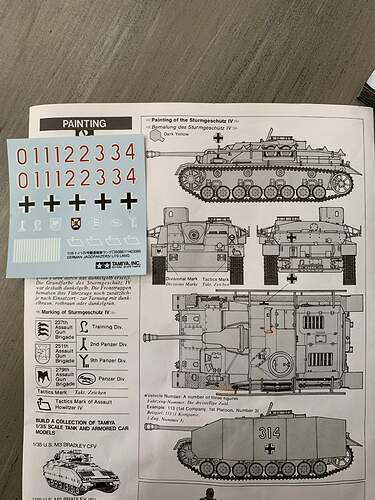I agree with all of the advice you’ve got about how to apply the decals and also for applying glazes. I generally apply decals before doing a lot of weathering so that the effects of time, climate and dirt are also shown in the markings.
I prefer the airbrushed glaze technique, myself, but I also use a lot of other weathering / finishing techniques together with that. All that’s really important is how the effects combine to create the final result. The path to get there is not so critical. There’s a logic to the sequence that you might use, so consider how each layer or effect builds on the earlier layers and how the overall finish is arrived at.
Your observation about wanting the glaze (either air or hand brushed) over the markings to help “blend” then in to the overall finish is a good example of this logic in action.
In regard to your question about the suitability of the divisional unit marking with your “tank riders,” the only visual difference between Panzergrandiers and regular infantry would be the color of the Waffenfarbe “branch of service color”) used on some of their insignia - shoulder board piping and collar Litzen (collar “tabs”). Panzergrenadiers would use a “grass” green (also variously described in references as lime green or yellow-green) and regular infantry would use white.
By the time the StuG IV was being fielded, almost all German army soldiers would be wearing uniforms with the later Einheits (“universal”) insignia, so collar Litzen wouldn’t have the Waffenfarbe lights. This would leave the only branch colors on the piping on their shoulder boards.
Of course, troops that have been serving longer might also be wearing older uniforms which might then have earlier versions of the insignia already on them. So, mixtures of older uniform variations with newer (but only up to the date of your model) are realistically possible.
So, as a practical matter, the only difference between making your tank riders Panzergranadier vs. regular infantry would be how you paint their insignia (or which insignia decals you use, if you go that route). Thus, the use of the independent assault gun brigade or divisional insignia sort of depends on how you paint the tank riders than anything else. Of course, that beings up the related matter of the uniforms of the StuG crew which also showed branch of service variations.
A StuG issued to a Panzer regiment as a substitute for a tank would likely be crewed by Panzer troops who would be wearing insignia with pink Waffenfarbe insignia piping.
A StuG issued to an assault gun unit, either in a independent assault gun brigade or in an organic divisional assault gun company would likely be wearing a mix of Waffenfarbe. Drivers were generally trained in schools operated by the Panzer branch, but loaders, gunners and commanders were generally recruited and trained by the artillery branch (since the assault gun was an artillery branch weapon first and foremost). Those crew members would be wearing red piping.
Of course, there all all sorts of exceptions, so, for example, assault guns issued to and manned by troops in the LW or SS would have entirely different uniforms. A soldier who might have started off as a driver in an assault gun brigade could have been promoted and given the position as a StuG commander, so he could be wearing pink Panzer waffenfarbe while most of his peers are wearing artillery red, etc., etc., etc…
